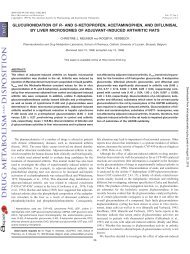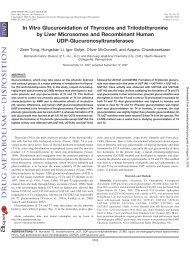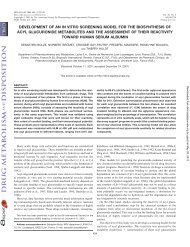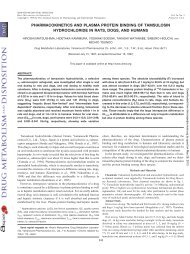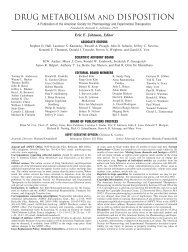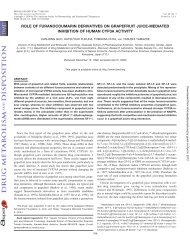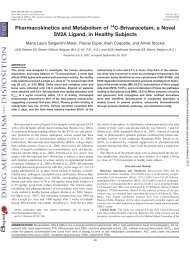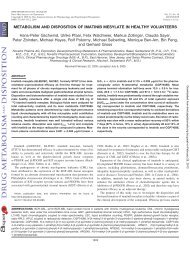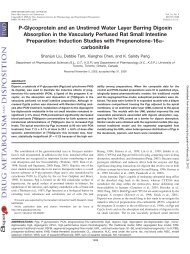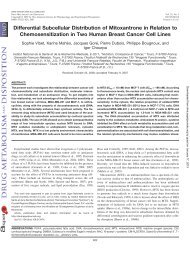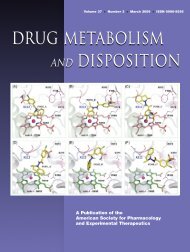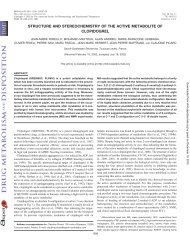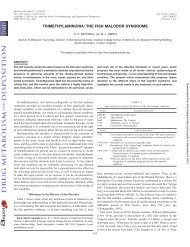Influence of the Cyp1B1 L432V Gene Polymorphism and - Drug ...
Influence of the Cyp1B1 L432V Gene Polymorphism and - Drug ...
Influence of the Cyp1B1 L432V Gene Polymorphism and - Drug ...
Create successful ePaper yourself
Turn your PDF publications into a flip-book with our unique Google optimized e-Paper software.
0090-9556/09/3707-1490–1495$20.00<br />
DRUG METABOLISM AND DISPOSITION Vol. 37, No. 7<br />
Copyright © 2009 by The American Society for Pharmacology <strong>and</strong> Experimental Therapeutics 27060/3481761<br />
DMD 37:1490–1495, 2009 Printed in U.S.A.<br />
<strong>Influence</strong> <strong>of</strong> <strong>the</strong> <strong>Cyp1B1</strong> <strong>L432V</strong> <strong>Gene</strong> <strong>Polymorphism</strong> <strong>and</strong> Exposure<br />
to Tobacco Smoke on <strong>Cyp1B1</strong> mRNA Expression<br />
in Human Leukocytes<br />
ABSTRACT:<br />
Simone Helmig, Bahar Hadzaad, 1 Juliane Döhrel, <strong>and</strong> Joachim Schneider<br />
Institut und Poliklinik für Arbeits- und Sozialmedizin, Justus-Liebig-Universität, Giessen, Germany<br />
Cytochrome P450 1B1 (CYP1B1), a phase I enzyme, is involved in<br />
<strong>the</strong> activation <strong>of</strong> a broad spectrum <strong>of</strong> procarcinogens. An association<br />
<strong>of</strong> <strong>the</strong> <strong>Cyp1B1</strong> <strong>L432V</strong> polymorphism with diverse types <strong>of</strong><br />
cancer, as well as an impact on <strong>the</strong> catalytic activity <strong>of</strong> <strong>the</strong> enzyme,<br />
has been described. To show <strong>the</strong> functional impact <strong>of</strong> <strong>the</strong> allelic<br />
variant <strong>Cyp1B1</strong>*3, we investigated <strong>the</strong> quantitative <strong>Cyp1B1</strong> mRNA<br />
expression in a population <strong>of</strong> smokers, nonsmokers, <strong>and</strong> ex-smokers<br />
<strong>and</strong> determined <strong>the</strong>ir genotypes. Detection <strong>of</strong> <strong>the</strong> <strong>L432V</strong> polymorphism<br />
in exon 3 <strong>of</strong> <strong>the</strong> <strong>Cyp1B1</strong> gene was performed by rapid<br />
capillary polymerase chain reaction (PCR) with melting curve analysis.<br />
For quantitative comparison <strong>of</strong> <strong>Cyp1B1</strong> mRNA levels, realtime<br />
PCR was performed using SYBR Green fluorescence in a<br />
LightCycler system. Calculations <strong>of</strong> expression were made with<br />
<strong>the</strong> 2 ���CT method. In comparing relative <strong>Cyp1B1</strong> mRNA expres-<br />
To have a carcinogenic effect most environmental compounds<br />
require a metabolic initiation to reactivate electrophilic intermediates<br />
by <strong>the</strong> cytochrome P450 (P450) monooxygenase system (Bartsch et<br />
al., 2000). CYP1B1 is a phase I enzyme that belongs to a multigene<br />
superfamily <strong>of</strong> monomeric mixed-function monooxygenases (Sutter et<br />
al., 1994). It is involved in <strong>the</strong> activation <strong>of</strong> a broad spectrum <strong>of</strong><br />
procarcinogens, for example, components <strong>of</strong> tobacco smoke such as<br />
polycyclic aromatic hydrocarbons (PAHs). The expression <strong>of</strong> <strong>the</strong><br />
<strong>Cyp1B1</strong> gene is induced through <strong>the</strong> aromatic hydrocarbon receptor<br />
(AhR), which is activated by PAHs (Furukawa et al., 2004). Because<br />
<strong>Cyp1B1</strong> expression can easily be determined in peripheral blood<br />
lymphocytes, it is <strong>of</strong>ten promoted as a biomarker <strong>of</strong> exposure to<br />
environmental AhR agonists (van Duursen et al., 2005b).<br />
CYP1B1 is expressed in many normal human tissues, including<br />
peripheral blood cells (Hanaoka et al., 2002). In addition, <strong>Cyp1B1</strong> is<br />
found to be overexpressed in a variety <strong>of</strong> human tumors (Murray et<br />
al., 1997).<br />
Some <strong>of</strong> <strong>the</strong> results are included in <strong>the</strong> following <strong>the</strong>sis: Hadzaad B (2009)<br />
<strong>Gene</strong>xpression der Cytochrome P450 1B1 und 2E1 in Abhăngigkeit einer PAH-<br />
Einwirkung infolge Rauchens sowie der individuellen Suszeptibilität. Ph.D. <strong>the</strong>sis,<br />
Justus-Leibig-Universität Gießen, Gießen, Germany.<br />
Article, publication date, <strong>and</strong> citation information can be found at<br />
http://dmd.aspetjournals.org.<br />
doi:10.1124/dmd.109.027060.<br />
Received February 6, 2009; accepted April 3, 2009<br />
sion, highly significant differences between <strong>the</strong> two homozygote<br />
genotypes *1/*1 <strong>and</strong> *3/*3 (0.185 � 0.027, n � 118 versus 0.071 �<br />
0.013, n � 56; p � 0.000), as well as between <strong>the</strong> heterozygote<br />
genotype *1/*3 <strong>and</strong> <strong>the</strong> homozygote genotype *3/*3 (0.178 � 0.025,<br />
n � 171 versus 0.071 � 0.013, n � 56; p � 0.000), were revealed.<br />
Significant differences between <strong>the</strong> genotypes were also detected<br />
within <strong>the</strong> subgroups <strong>of</strong> smokers, nonsmokers, <strong>and</strong> ex-smokers.<br />
No significant differences were determined in comparing <strong>the</strong> relative<br />
<strong>Cyp1B1</strong> mRNA expression with regard to tobacco smoke<br />
exposure. Our results suggest that genotypes carrying <strong>the</strong> C allele<br />
(*1/*1 <strong>and</strong> *1/*3) at<strong>Cyp1B1</strong> <strong>L432V</strong> polymorphism have a significantly<br />
higher <strong>Cyp1B1</strong> mRNA expression compared with <strong>the</strong> genotype<br />
without <strong>the</strong> C allele (*3/*3). <strong>Gene</strong> expression <strong>of</strong> <strong>Cyp1B1</strong> mRNA<br />
cannot be used as a biomarker for exposure <strong>of</strong> tobacco smoke.<br />
Molecular epidemiology can have an important impact when analyzing<br />
<strong>the</strong> complexity <strong>of</strong> gene-environment interactions at <strong>the</strong> molecular<br />
level. Whereas gene mutations <strong>of</strong> high penetration <strong>of</strong>ten result in<br />
a high risk for cancer (Caporaso <strong>and</strong> Goldstein, 1995), polymorphisms<br />
<strong>of</strong> genes with low penetration (such as <strong>Cyp1B1</strong>) are thought to<br />
predispose <strong>the</strong> individual risk if <strong>the</strong>re is exposure to a certain chemical<br />
(Wünsch Filho <strong>and</strong> Zago, 2005). Although <strong>Cyp1B1</strong> expression is<br />
frequently investigated as a biomarker, <strong>the</strong> polymorphisms are seldom<br />
considered. Several genetic polymorphisms have been identified in<br />
<strong>the</strong> <strong>Cyp1B1</strong> gene. For example, <strong>the</strong> <strong>L432V</strong> polymorphism was reported<br />
to be associated with a higher catalytic activity <strong>of</strong> <strong>the</strong> enzyme<br />
(Li et al., 2000; Aklillu et al., 2002). This increase in catalytic activity<br />
may be caused through changes in <strong>the</strong> tertiary or quaternary structure<br />
<strong>of</strong> <strong>the</strong> <strong>Cyp1B1</strong> protein because <strong>the</strong> <strong>L432V</strong> polymorphism is located<br />
near a catalytically important heme-binding domain in <strong>the</strong> <strong>Cyp1B1</strong><br />
gene (Sissung et al., 2006). Fur<strong>the</strong>rmore, <strong>the</strong> <strong>Cyp1B1</strong>*3 haplotype<br />
was associated with an increased <strong>Cyp1B1</strong> mRNA expression in lymphocytes<br />
when treated in vitro with 2,3,7,8-tetrachlorodibenzo-pdioxin<br />
(TCDD) (L<strong>and</strong>i et al., 2005). For <strong>Cyp1B1</strong> allele nomenclature,<br />
refer to <strong>the</strong> home page <strong>of</strong> <strong>the</strong> Human Cytochrome P450 Allele<br />
Nomenclature Committee (www.cypalleles.ki.se/). The <strong>Cyp1B1</strong><br />
4326C�G polymorphism causes an amino acid exchange<br />
(rs1056836). The C allele codes for Leu432, <strong>and</strong> <strong>the</strong> G allele codes for<br />
Val432 (Table 1). An association <strong>of</strong> this polymorphism with <strong>the</strong><br />
ABBREVIATIONS: P450, cytochrome P450; PAH, polycyclic aromatic hydrocarbon; AhR, aromatic hydrocarbon receptor; TCDD, 2,3,7,8tetrachlorodibenzo-p-dioxin;<br />
PCR, polymerase chain reaction; B2M, �-2-microglobulin.<br />
1490<br />
Downloaded from<br />
dmd.aspetjournals.org by guest on February 12, 2013
<strong>Cyp1B1</strong> <strong>L432V</strong> GENE POLYMORPHISM AND <strong>Cyp1B1</strong> mRNA EXPRESSION<br />
incidence <strong>of</strong> head <strong>and</strong> neck squamous cancer (Ko et al., 2001), lung<br />
cancer susceptibility (Wenzlaff et al., 2005), renal cancer (Sasaki et<br />
al., 2004), <strong>and</strong> colorectal cancer (Fritsche et al., 1999) has been<br />
reported. The ability to identify individuals at highest risk <strong>of</strong> cancer is<br />
important for cancer control strategies. The fact that 20% <strong>of</strong> lung<br />
cancer cases occur in nonsmokers is <strong>of</strong>ten attributed to a combination<br />
<strong>of</strong> genetic factors (Gorlova et al., 2007). Therefore, we investigate <strong>the</strong><br />
functional impact <strong>of</strong> <strong>the</strong> allelic variant <strong>Cyp1B1</strong>*3 on quantitative<br />
<strong>Cyp1B1</strong> mRNA expression in a population <strong>of</strong> smokers, nonsmokers,<br />
<strong>and</strong> ex-smokers in relation to <strong>the</strong>ir <strong>Cyp1B1</strong> genotypes.<br />
Materials <strong>and</strong> Methods<br />
Subjects. The study population consisted <strong>of</strong> 365 whites. Volunteers were<br />
personnel <strong>of</strong> <strong>the</strong> Universitätsklinikum Giessen <strong>and</strong> Marburg GmbH, students<br />
<strong>of</strong> <strong>the</strong> Justus-Liebig-Universität Giessen, <strong>and</strong> patients recruited at <strong>the</strong> Policlinic<br />
<strong>of</strong> <strong>the</strong> Institute for Arbeits- <strong>and</strong> Sozialmedizin, Giessen, Germany.<br />
All <strong>of</strong> <strong>the</strong> subjects included in this study were interviewed using a questionnaire<br />
to obtain information on lifestyle, including smoking habits, alcohol<br />
consumption, indoor air pollution (coal heating <strong>and</strong> cooking), eating habits,<br />
lifetime occupational history, <strong>and</strong> disease history. The group comprised 271<br />
males (mean age, 56 years; range, 20–91 years) <strong>and</strong> 93 females (mean age, 40<br />
years; range, 16–82 years). The subgroup smokers (n � 107) was defined as<br />
people who smoke daily; nonsmokers (n � 103) were defined as people who<br />
had never smoked; <strong>and</strong> ex-smokers (n � 155) were defined as people who had<br />
quit smoking at least 3 months ago. The ethics committees <strong>of</strong> <strong>the</strong> University<br />
Hospital, Giessen, Germany approved <strong>the</strong> study.<br />
Real-Time Polymerase Chain Reaction <strong>and</strong> <strong>Polymorphism</strong> Detection.<br />
Blood samples (approximately 3 ml) were obtained from all <strong>the</strong> subjects.<br />
Genomic DNA was isolated from whole blood using <strong>the</strong> versa<strong>Gene</strong> DNA<br />
Purification Kit (Gentra Systems, Minneapolis, MN). Detection <strong>of</strong> <strong>the</strong> <strong>L432V</strong><br />
polymorphism in exon 3 <strong>of</strong> <strong>the</strong> <strong>Cyp1B1</strong> gene was performed by rapid capillary<br />
polymerase chain reaction (PCR) with melting curve analysis using fluorescence-labeled<br />
hybridization probes in a LightCycler System (Roche Diagnostics,<br />
Mannheim, Germany) (Brüning et al., 1999). Both negative <strong>and</strong> positive<br />
controls were included in each PCR reaction. TIB MOLBIOL (Berlin, Germany)<br />
syn<strong>the</strong>sized <strong>the</strong> PCR primers <strong>and</strong> <strong>the</strong> fluorescent-labeled detection<br />
probes. The primers <strong>Cyp1B1</strong>-forward (5�-GAAATAAGAATTTTGCTCACT-<br />
TGC-3�) <strong>and</strong> <strong>Cyp1B1</strong>-reverse (5�-CTTAGAAAGTTCTTCGCCAATG-3�)<br />
amplify a 441-base pair fragment <strong>of</strong> <strong>the</strong> <strong>Cyp1B1</strong> gene that includes codon 432<br />
containing <strong>the</strong> sequences CTG or GTG, coding for leucine or valine, respectively.<br />
The fluorescein-labeled probe (ATGACCCACTGAAGTGACCTA-<br />
ACCC-FL) <strong>and</strong> <strong>the</strong> LC-Red640-labeled probe (LC640-AACTTTGATC-<br />
CAGCTCGATTCTTGGACAA-PH) bind to nucleotides 8123 through 8147<br />
<strong>and</strong> 8152 through 8180 within <strong>the</strong> human <strong>Cyp1B1</strong> gene (GenBank entry<br />
U56438), respectively. Therefore, <strong>the</strong> expected melting curve in a C allele will<br />
be higher than in a G allele. The samples homozygous for <strong>the</strong> C allele<br />
(<strong>Cyp1B1</strong>*1/*1) contain a single peak <strong>and</strong> a melting temperature <strong>of</strong> 63°C, <strong>and</strong><br />
samples homozygous for <strong>the</strong> G allele (<strong>Cyp1B1</strong>*3/*3) show a single peak at<br />
55°C. Heterozygous (<strong>Cyp1B1</strong>*1/*3) samples give rise to biphasic melting<br />
curves (Fig. 1). In <strong>the</strong> following <strong>the</strong> homozygous genotype <strong>Cyp1B1</strong>*1/*1 is<br />
denoted “*1/*1”; <strong>the</strong> heterozygous genotype <strong>Cyp1B1</strong>*1/*3 is denoted “*1/*3”;<br />
<strong>and</strong> <strong>the</strong> homozygous genotype <strong>Cyp1B1</strong>*3/*3 is denoted “*3/*3” (Fig. 1).<br />
The reaction mixture comprised 1� FastStart DNA Master Hybridization<br />
Probes (Roche Diagnostics), primers <strong>Cyp1B1</strong>-forward (0.55 �M) <strong>and</strong><br />
<strong>Cyp1B1</strong>-reverse (1.1 �M), sensor (0.275 �M), anchor (0.275 �M), MgCl2 (3<br />
mM), <strong>and</strong> 25 ng <strong>of</strong> genomic DNA in a 10-�l reaction mixture. PCR contamination<br />
was checked by <strong>the</strong> inclusion <strong>of</strong> a negative control. PCRs were initially<br />
denatured at 95°C for 10 min <strong>and</strong> subjected to 50 cycles <strong>of</strong> amplification with<br />
TABLE 1<br />
<strong>Cyp1B1</strong> <strong>L432V</strong> polymorphism<br />
Homozygote Wild-Type Heterozygote Homozygote Mutant<br />
Genotypes <strong>Cyp1B1</strong>*1/*1 <strong>Cyp1B1</strong>*1/*3 <strong>Cyp1B1</strong>*3/*3<br />
Nucleotides C/C C/G G/G<br />
Amino acids Leu/Leu Leu/Val Val/Val<br />
1491<br />
5 s <strong>of</strong> denaturing at 95°C, 20 s <strong>of</strong> annealing at 56°C, <strong>and</strong> 35 s <strong>of</strong> extension at<br />
72°C. The melting curve was achieved by 2sat95°C, 30 s at 40°C, <strong>and</strong> 1 s<br />
at 90°C, 0.1°C/s.<br />
RNA Extraction <strong>and</strong> Reverse Transcription. White blood cells were<br />
isolated from 10 ml <strong>of</strong> peripheral blood using Ficoll (GE Healthcare, Little<br />
Chalfont, Buckinghamshire, UK) as described by <strong>the</strong> manufacturer. Total RNA<br />
was isolated from white blood cells using a commercial RNA isolation reagent<br />
(TRI Reagent; Sigma-Aldrich, St. Louis, MO) according to <strong>the</strong> manufacturer’s<br />
instructions. Isolated RNA was resuspended in 10 �l <strong>of</strong> RNase-free water.<br />
Each sample was treated twice with 2 �l <strong>of</strong> RNase-free DNase, 1 unit/�l<br />
(QIAGEN, Valencia, CA), for 10 min at 37°C to eliminate remaining DNA.<br />
The prepared RNA was reverse-transcribed to syn<strong>the</strong>size cDNA. Reversetranscriptase<br />
reactions were performed for 1hat37°C in a final volume <strong>of</strong> 10<br />
�l using 1 �g <strong>of</strong> RNA, 500 ng <strong>of</strong> oligo(dT)15 (Promega, Mannheim, Germany),<br />
10 mM dNTPs (Fermentas Inc., Glen Burnie, MD), 8 units <strong>of</strong> RNasin<br />
(Promega), <strong>and</strong> 3 units <strong>of</strong> AMV Reverse Transcriptase <strong>and</strong> 1� AMV Reverse<br />
Transcriptase Reaction buffer (Promega).<br />
Real-Time PCR. For quantitative comparison <strong>of</strong> <strong>Cyp1B1</strong> mRNA levels<br />
real-time PCR was performed using SYBR Green fluorescence in a Light-<br />
Cycler System (Roche Diagnostics). After optimization <strong>of</strong> PCR conditions,<br />
amplification efficiency was tested in st<strong>and</strong>ard curves using serial cDNA<br />
dilutions. The correlation coefficient had to be greater than 0.9 <strong>and</strong> <strong>the</strong> slope<br />
around �3.5. Amplification specificity was checked using melting curves.<br />
Both negative <strong>and</strong> positive controls were included in each PCR reaction. All<br />
<strong>the</strong> assays were carried out three times as independent PCR runs for each<br />
cDNA sample. <strong>Gene</strong> expression was always related to expression <strong>of</strong> �-2microglobulin<br />
(B2M) as housekeeping gene, which is known to be a good<br />
choice for normalization <strong>of</strong> <strong>the</strong> expression levels <strong>of</strong> leukocytes (V<strong>and</strong>esompele<br />
et al., 2002). Calculations <strong>of</strong> expression were performed with <strong>the</strong> 2 ���CT<br />
method according to Pfaffl et al. (2001). The gene expression levels were<br />
rounded to three decimal places. The sequence <strong>of</strong> <strong>the</strong> specific primers for<br />
CYP1B1 <strong>and</strong> B2M was CYP1B1-forward (5�-AACCGCAACTTCAG-<br />
CAACTT-3�), CYP1B1-reverse (5�-GAGGATAAAGGCGTCCATCA-3�),<br />
B2M-forward (5�-ACTGAATTCACCCCCACTGA-3�), <strong>and</strong> B2M-reverse (5�-<br />
CCTCCATGATGATGCTTACA-3�). PCR reactions were carried out in a final<br />
volume <strong>of</strong> 20 �l using 1� ABsolute quantitative PCR SYBR Green capillary<br />
mixes (ABgene, Epsom, Surrey, UK), 300 nM B2M primers or 600 nM<br />
<strong>Cyp1B1</strong> primers, <strong>and</strong> 2 �l <strong>of</strong> cDNA. The PCR conditions for <strong>Cyp1B1</strong> were as<br />
follows: initial denaturation 15 min at 95°C, touchdown PCR 2 cycles <strong>of</strong> 95°C<br />
for 10 s, 67°C for 10 s, <strong>and</strong> 72°C for 25 s; 2 cycles <strong>of</strong> 95°C for 10 s, 65°C for<br />
10 s, <strong>and</strong> 72°C for 25 s; 2 cycles <strong>of</strong> 95°C for 10 s, 63°C for 10 s, <strong>and</strong> 72°C for<br />
25 s; <strong>and</strong> 45 cycles <strong>of</strong> 95°C for 10 s, 61°C for 10 s, <strong>and</strong> 72°C for 25 s. The PCR<br />
conditions for B2M were as follows: initial denaturation 15 min at 95°C <strong>and</strong><br />
PCR 55 cycles <strong>of</strong> 95°C for 10 s, 63°C for 10 s, <strong>and</strong> 72°C for 10 s.<br />
All <strong>of</strong> <strong>the</strong> measurements were made without information about <strong>the</strong> origin <strong>of</strong><br />
<strong>the</strong> samples <strong>and</strong> were performed in triplicate. After amplification reaction,<br />
products were controlled <strong>and</strong> separated on 2% agarose gels, stained with<br />
SYBR Safe, <strong>and</strong> photographed under UV illumination.<br />
Statistical Analysis. Smokers were considered current smokers at <strong>the</strong> time<br />
<strong>of</strong> blood withdrawal. Ex-smokers were all <strong>the</strong> individuals who were previously<br />
smokers but had quit smoking at least 3 months before blood withdrawal.<br />
Information was collected on <strong>the</strong> usual number <strong>of</strong> cigarettes smoked per day,<br />
<strong>the</strong> age at which <strong>the</strong> subject started smoking, <strong>and</strong>, if <strong>the</strong> person was an<br />
ex-smoker, <strong>the</strong> age <strong>and</strong> time at which <strong>the</strong> subject stopped smoking. One<br />
pack-year was defined as smoking 20 cigarettes daily for 1 year. All <strong>of</strong> <strong>the</strong><br />
statistical analyses were performed using <strong>the</strong> statistical s<strong>of</strong>tware package SSPS<br />
15.0 (SPSS Inc., Chicago, IL). Allelic <strong>and</strong> genotype frequencies were obtained<br />
by direct counting. Hardy-Weinberg equilibrium was assessed by a � 2 test with<br />
1 degree <strong>of</strong> freedom. Results are expressed as mean � S.E.M. Means in<br />
Downloaded from<br />
dmd.aspetjournals.org by guest on February 12, 2013
1492 HELMIG ET AL.<br />
FIG. 1. Melting curve analysis <strong>of</strong> <strong>the</strong> <strong>Cyp1B1</strong> <strong>L432V</strong> polymorphism using LightCycler. Fluorescence data were converted to derivative melting curves by plotting <strong>the</strong><br />
negative derivative <strong>of</strong> <strong>the</strong> fluorescence with respect to temperature versus temperature [K(dF/dT) versus T] <strong>and</strong> show two different melting maxima (T m), one for each allele.<br />
Melting maxima for <strong>the</strong> <strong>Cyp1B1</strong> <strong>L432V</strong> polymorphism were 55°C for <strong>the</strong> G/G genotype (<strong>Cyp1B1</strong>*3/*3), 55 <strong>and</strong> 63°C for <strong>the</strong> heterozygous C/G genotype (<strong>Cyp1B1</strong>*1/*3),<br />
<strong>and</strong> 63°C for <strong>the</strong> homozygous C/C genotype (<strong>Cyp1B1</strong>*1/*1).<br />
different subgroups were analyzed by Student’s t test, one-way analysis <strong>of</strong><br />
variance, followed by Duncan <strong>and</strong> Student-Newman-Keuls post hoc analysis,<br />
<strong>and</strong> U test. A value <strong>of</strong> p � 0.05 was regarded as significant.<br />
Results<br />
Allele Frequencies. To determine whe<strong>the</strong>r our studied population<br />
does not deviate from Hardy-Weinberg equilibrium <strong>and</strong> whe<strong>the</strong>r allele<br />
frequencies were within o<strong>the</strong>r published frequencies, we investigated<br />
allele <strong>and</strong> genotype frequencies in <strong>the</strong> total population as well as in all<br />
<strong>the</strong> subgroups. In <strong>the</strong> total population <strong>the</strong> allele frequency for quantitative<br />
(<strong>Cyp1B1</strong>*3) was 0.415. This allele frequency is similar to<br />
o<strong>the</strong>r observed frequencies in various healthy white populations <strong>and</strong><br />
did not significantly deviate from <strong>the</strong> Hardy-Weinberg equilibrium<br />
(p � 0.1 � 1 � �). The allele frequencies <strong>of</strong> <strong>Cyp1B1</strong>*3 were not<br />
statistically different within <strong>the</strong> subgroups smokers quantitative<br />
(<strong>Cyp1B1</strong>*3) � 0.43, nonsmokers quantitative (<strong>Cyp1B1</strong>*3) � 0.40,<br />
<strong>and</strong> ex-smokers quantitative (<strong>Cyp1B1</strong>*3) � 0.42, <strong>and</strong> <strong>the</strong>y did not<br />
deviate from <strong>the</strong> Hardy-Weinberg equilibrium (p � 0.1 � 1 � �).<br />
Allele frequencies were also not different within <strong>the</strong> male quantitative<br />
(<strong>Cyp1B1</strong>*3) � 0.415 or female quantitative (<strong>Cyp1B1</strong>*3) � 0.414<br />
subgroups, <strong>and</strong> <strong>the</strong>y did not deviate from <strong>the</strong> Hardy-Weinberg equilibrium<br />
males (p � 0.1 � 1 � �) <strong>and</strong> females (p � 0.1 � 1 � �).<br />
<strong>Cyp1B1</strong> mRNA Expression. To investigate <strong>the</strong> functional impact<br />
<strong>of</strong> <strong>the</strong> <strong>Cyp1B1</strong> allelic variants <strong>the</strong> quantitative <strong>Cyp1B1</strong> mRNA expression<br />
among <strong>the</strong> different genotypes for <strong>Cyp1B1</strong> <strong>L432V</strong> polymorphism<br />
(*1/*1, *1/*3, *3/*3) was analyzed. Comparing <strong>the</strong> mean �<br />
S.E. <strong>of</strong> <strong>the</strong> relative <strong>Cyp1B1</strong> mRNA expression revealed significant<br />
differences between <strong>the</strong> two homozygote genotypes *1/*1 <strong>and</strong> *3/*3<br />
(0.185 � 0.027, n � 118 versus 0.071 � 0.013, n � 56; p � 0.000)<br />
<strong>and</strong> between <strong>the</strong> heterozygote genotype *1/*3 <strong>and</strong> *3/*3 (0.178 �<br />
0.025, n � 171 versus 0.071 � 0.013, n � 56; p � 0.000). These<br />
results suggest that genotypes carrying <strong>the</strong> C allele (*1/*1 <strong>and</strong> *1/*3)<br />
have a significantly higher <strong>Cyp1B1</strong> mRNA expression compared with<br />
<strong>the</strong> genotype without <strong>the</strong> C allele (*3/*3) (Fig. 2).<br />
To fur<strong>the</strong>r investigate <strong>the</strong> functional impact <strong>of</strong> <strong>the</strong> <strong>Cyp1B1</strong> allelic<br />
variants <strong>and</strong> to exclude a tobacco smoke influence, <strong>the</strong> quantitative<br />
FIG. 2. Quantitative mRNA expression <strong>of</strong> <strong>Cyp1B1</strong> in leukocytes was determined<br />
among <strong>the</strong> different genotypes for <strong>Cyp1B1</strong> <strong>L432V</strong>. Significant differences in<br />
<strong>Cyp1B1</strong> expression between <strong>the</strong> subgroups *1/*1 <strong>and</strong> *3/*3 <strong>and</strong> between <strong>the</strong><br />
subgroups *1/*3 <strong>and</strong> *3/*3 were observed. Therefore, genotypes containing <strong>the</strong> C<br />
allele had a significantly higher <strong>Cyp1B1</strong> mRNA expression compared with <strong>the</strong><br />
genotype without a C allele. Data are shown as mean � S.E., �, p � 0.05.<br />
<strong>Cyp1B1</strong> mRNA expression was analyzed within <strong>the</strong> subgroups smokers,<br />
nonsmokers, <strong>and</strong> ex-smokers. In each subgroup <strong>the</strong> relative<br />
<strong>Cyp1B1</strong> mRNA expression was compared between <strong>the</strong> three different<br />
genotypes *1/*1, *1/*3, <strong>and</strong> *3/*3. A significant difference <strong>of</strong> <strong>the</strong><br />
mean � S.E. between <strong>the</strong> homozygote genotypes *1/*1 <strong>and</strong> *3/*3 was<br />
detected within <strong>the</strong> subgroup smokers (0.169 � 0.043, n � 33 versus<br />
0.056 � 0.016, n � 19; p � 0.020) <strong>and</strong> nonsmokers (0.219 � 0.063,<br />
n � 34 versus 0.064 � 0.019, n � 14; p � 0.025), respectively.<br />
Significant differences <strong>of</strong> <strong>the</strong> mean � S.E. between <strong>the</strong> heterozygote<br />
genotype *1/*3 <strong>and</strong> <strong>the</strong> homozygote genotype *3/*3 were revealed<br />
within <strong>the</strong> subgroups smokers (0.205 � 0.058, n � 50 versus 0.056 �<br />
0.016, n � 19; p � 0.018) <strong>and</strong> ex-smokers (0.181 � 0.084, n � 72<br />
versus 0.084 � 0.027, n � 24; p � 0.024), respectively (Fig. 3). These<br />
findings confirm that <strong>the</strong> genotypes containing a C allele have a<br />
significantly higher <strong>Cyp1B1</strong> mRNA expression compared with <strong>the</strong><br />
genotype without a C allele.<br />
To determine whe<strong>the</strong>r <strong>Cyp1B1</strong> is activated in leukocytes by components<br />
<strong>of</strong> tobacco smoke, we analyzed <strong>the</strong> quantitative mRNA ex-<br />
Downloaded from<br />
dmd.aspetjournals.org by guest on February 12, 2013
<strong>Cyp1B1</strong> <strong>L432V</strong> GENE POLYMORPHISM AND <strong>Cyp1B1</strong> mRNA EXPRESSION<br />
FIG. 3. Quantitative mRNA expression <strong>of</strong> <strong>Cyp1B1</strong> was determined among <strong>the</strong><br />
different genotypes for <strong>Cyp1B1</strong> <strong>L432V</strong> within <strong>the</strong> subgroups smokers, nonsmokers,<br />
<strong>and</strong> ex-smokers. Significant differences were observed between <strong>the</strong> genotypes *1/*1<br />
<strong>and</strong> *3/*3 within <strong>the</strong> subgroups smokers <strong>and</strong> nonsmokers <strong>and</strong> between <strong>the</strong> genotypes<br />
*1/*3 <strong>and</strong> *3/*3 within <strong>the</strong> subgroups nonsmokers <strong>and</strong> ex-smokers. Therefore,<br />
genotypes containing <strong>the</strong> C allele had a significantly higher <strong>Cyp1B1</strong> mRNA expression<br />
within <strong>the</strong> subgroups. Data are shown as mean � S.E., �, p � 0.05.<br />
pression <strong>of</strong> <strong>Cyp1B1</strong> in relation to smoking habits. Comparing <strong>the</strong><br />
mean <strong>and</strong> <strong>the</strong> S.E. <strong>of</strong> <strong>the</strong> relative <strong>Cyp1B1</strong> mRNA expression between<br />
smokers (0.167 � 0.033, n � 101), nonsmokers (0.191 � 0.037, n �<br />
98), <strong>and</strong> ex-smokers (0.149 � 0.017, n � 148) did not reveal any<br />
significant differences (Fig. 4).<br />
Fur<strong>the</strong>rmore, <strong>the</strong> quantitative <strong>Cyp1B1</strong> mRNA expression was analyzed<br />
within <strong>the</strong> different genotypes (*1/*1, *1/*3, *3/*3). Means �<br />
S.E. were compared between smokers, nonsmokers, <strong>and</strong> ex-smokers.<br />
In accordance with <strong>the</strong> results in <strong>the</strong> total population, no significant<br />
differences in <strong>Cyp1B1</strong> mRNA expression between smokers, nonsmokers,<br />
<strong>and</strong> ex-smokers were determined (Fig. 5).<br />
<strong>Cyp1B1</strong> plays a crucial role in metabolizing xenobiotics such as<br />
PAHs, but it is also responsible for hormone metabolism. <strong>Cyp1B1</strong> is<br />
known to be <strong>the</strong> most catalytically efficient E2 hydroxylase (Spink et<br />
al., 1998). Therefore, we divided <strong>the</strong> total population into males (n �<br />
271) <strong>and</strong> females (n � 93). Within <strong>the</strong>se two groups, quantitative<br />
mRNA expression <strong>of</strong> <strong>Cyp1B1</strong> was determined <strong>and</strong> compared between<br />
<strong>the</strong> different genotypes for <strong>Cyp1B1</strong> <strong>L432V</strong> (*1/*1, *1/*3, *3/*3).<br />
Significant differences were only observed within <strong>the</strong> male group.<br />
Here, <strong>the</strong> relative <strong>Cyp1B1</strong> mRNA expression was significantly higher<br />
in C allele-carrying homozygote <strong>and</strong> heterozygote genotypes than in<br />
<strong>the</strong> homozygote genotype without a C allele (0.139 � 0.022, n � 90<br />
versus 0.062 � 0.010, n � 44; p � 0.000 <strong>and</strong> 0.138 � 0.020, n � 124<br />
versus 0.062 � 0.010, n � 44; p � 0.026, respectively). The higher<br />
1493<br />
FIG. 4. Quantitative mRNA expression <strong>of</strong> <strong>Cyp1B1</strong> in leukocytes was determined in<br />
a group <strong>of</strong> smokers (n � 101), nonsmokers (n � 98), <strong>and</strong> ex-smokers (n � 148). No<br />
significant difference in <strong>Cyp1B1</strong> gene expression between <strong>the</strong> subgroups was<br />
observed. Data are shown as mean � S.E., �, p � 0.05.<br />
<strong>Cyp1B1</strong> mRNA expression in females compared with males is worth<br />
noting (Fig. 6).<br />
Discussion<br />
In this study, we show an influence <strong>of</strong> <strong>the</strong> <strong>Cyp1B1</strong> <strong>L432V</strong> polymorphism<br />
on its <strong>Cyp1B1</strong> mRNA expression in human lymphocytes in<br />
relation to interindividual differences by PAH induction through<br />
tobacco smoke. Therefore, we investigated <strong>the</strong> quantitative mRNA<br />
expression <strong>and</strong> <strong>the</strong> <strong>L432V</strong> genotypes <strong>of</strong> <strong>Cyp1B1</strong> in 365 white volunteers.<br />
The allele frequencies for <strong>the</strong> studied genotypes did not deviate<br />
from <strong>the</strong> Hardy-Weinberg equilibrium, <strong>and</strong> allele frequencies were<br />
similar to o<strong>the</strong>r published frequencies (Bailey et al., 1998; Brüning et<br />
al., 1999; Tang et al., 2000; Ko et al., 2001).<br />
FIG. 5. Quantitative mRNA expression <strong>of</strong> <strong>Cyp1B1</strong> was determined for <strong>the</strong> different<br />
smoking habits within <strong>the</strong> subgroups <strong>of</strong> different genotypes for <strong>Cyp1B1</strong> <strong>L432V</strong>. No<br />
significant differences were observed within <strong>the</strong> different genotypes *1/*1, *1/*3,<br />
<strong>and</strong> *3/*3 concerning smoking habits. Data are shown as mean � S.E., �, p � 0.05.<br />
Downloaded from<br />
dmd.aspetjournals.org by guest on February 12, 2013
1494 HELMIG ET AL.<br />
FIG. 6. Quantitative mRNA expression <strong>of</strong> <strong>Cyp1B1</strong> was determined among <strong>the</strong><br />
different genotypes for <strong>Cyp1B1</strong> <strong>L432V</strong> within <strong>the</strong> subgroups males (M) <strong>and</strong> females<br />
(F). Significant differences were only observed within <strong>the</strong> subgroup males. Here <strong>the</strong><br />
<strong>Cyp1B1</strong> expression was significantly higher in C allele-carrying genotypes (*1/*1,<br />
*1/*3) than in <strong>the</strong> genotype without a C allele (*3/*3). Worth noting is <strong>the</strong> higher<br />
<strong>Cyp1B1</strong> mRNA expression in females compared with males. Data are shown as<br />
mean � S.E., �, p � 0.05.<br />
We found significant differences in comparing <strong>the</strong> relative <strong>Cyp1B1</strong><br />
mRNA expression between <strong>the</strong> different <strong>Cyp1B1</strong> genotypes, suggesting<br />
that genotypes carrying <strong>the</strong> wild-type C allele (<strong>Cyp1B1</strong>*1 allele)<br />
have a significantly higher <strong>Cyp1B1</strong> mRNA expression compared with<br />
<strong>the</strong> genotype without <strong>the</strong> C allele. These findings were also confirmed<br />
when we divided <strong>the</strong> population into <strong>the</strong> subpopulations smokers,<br />
nonsmokers, <strong>and</strong> ex-smokers.<br />
Hanaoka et al. (2002) found a significant correlation between<br />
<strong>Cyp1B1</strong> mRNA expression <strong>and</strong> urinary 1-hydroxypyrene in subjects<br />
with <strong>the</strong> <strong>Cyp1B1</strong> 432 Leu/Leu wild-type genotype (<strong>Cyp1B1</strong>*1/*1)<br />
(Hanaoka et al., 2002). On <strong>the</strong> o<strong>the</strong>r h<strong>and</strong>, Hu et al. (2006) found a<br />
significantly higher mRNA expression in Taiwanese municipal waste<br />
incinerator workers carrying <strong>the</strong> <strong>Cyp1B1</strong>*3 allele (n � 9) compared<br />
with workers carrying <strong>the</strong> wild-type allele (n � 34). This finding was<br />
confirmed in workers exposed to high levels <strong>of</strong> PAH/dioxin only.<br />
Workers exposed to medium levels or controls showed an insignificantly<br />
lower <strong>Cyp1B1</strong> mRNA expression when carrying <strong>the</strong> <strong>Cyp1B1</strong>*3<br />
allele (n � 15 versus n � 48) (Hu et al., 2006). However, van Duursen<br />
et al. (2005a) found no statistically significant effects <strong>of</strong> <strong>Cyp1B1</strong><br />
<strong>L432V</strong> polymorphism on mRNA expression levels when studying<br />
human blood lymphocytes <strong>of</strong> 10 nonsmoking females (van Duursen et<br />
al., 2005b). In addition, no statistically significant differences were<br />
found in <strong>Cyp1B1</strong> mRNA expression when comparing <strong>the</strong> <strong>Cyp1B1</strong><br />
<strong>L432V</strong> polymorphism <strong>of</strong> 114 individuals living in a polychlorinated<br />
biphenyl-polluted area in Slovakia (van Duursen et al., 2005a). In<br />
contrast, subjects heterozygous or homozygous for <strong>the</strong> <strong>Cyp1B1</strong>*3<br />
allele showed a higher TCDD-induced <strong>Cyp1B1</strong> mRNA expression in<br />
mitogen-treated lymphocytes than subjects homozygous for <strong>the</strong><br />
<strong>Cyp1B1</strong>*1 allele (L<strong>and</strong>i et al., 2005). The low sample size in some<br />
studies <strong>and</strong> <strong>the</strong> different distribution <strong>of</strong> <strong>the</strong> <strong>Cyp1B1</strong> polymorphism<br />
among Chinese <strong>and</strong> whites (Tang et al., 2000) should be considered.<br />
The fact that mitogens cause lymphocytes to proliferate, which occurs<br />
concomitantly with an activation <strong>of</strong> several cell-signaling pathways<br />
<strong>and</strong> increases in gene transcription, should also be mentioned. Even<br />
when housekeeping genes are used for normalization, expression<br />
levels <strong>of</strong> <strong>Cyp1B1</strong> can be higher in mitogen-stimulated cells than in<br />
nonstimulated cells (van Duursen et al., 2005b). The genetic impact<br />
on <strong>the</strong> expression pattern <strong>of</strong> <strong>Cyp1B1</strong> is only one contributing factor,<br />
especially because post-transcriptional mechanisms have been suggested<br />
to be involved in regulation <strong>of</strong> <strong>Cyp1B1</strong> (McFadyen et al.,<br />
2003). Although <strong>the</strong> consequences <strong>of</strong> our findings are not yet clear,<br />
fur<strong>the</strong>r studies need to consider <strong>the</strong> <strong>Cyp1B1</strong> <strong>L432V</strong> polymorphism<br />
when investigating gene <strong>and</strong> protein expression <strong>of</strong> <strong>Cyp1B1</strong>.<br />
We did not find any significant differences in comparing <strong>the</strong><br />
<strong>Cyp1B1</strong> expression <strong>of</strong> smokers, nonsmokers, <strong>and</strong> ex-smokers. Fur<strong>the</strong>rmore,<br />
we did not find any differences in <strong>Cyp1B1</strong> expression <strong>of</strong><br />
smokers, nonsmokers, <strong>and</strong> ex-smokers when we divided <strong>the</strong> population<br />
into subpopulations by <strong>the</strong>ir different <strong>Cyp1B1</strong> genotypes. Therefore,<br />
we conclude that <strong>Cyp1B1</strong> gene expression levels in lymphocytes<br />
are not suitable to use as biomarkers <strong>of</strong> exposure to environmental or<br />
tobacco smoke PAHs. Never<strong>the</strong>less, a higher expression <strong>of</strong> <strong>Cyp1B1</strong><br />
was observed in bronchial epi<strong>the</strong>lial cells <strong>of</strong> smokers than in nonsmokers<br />
(Willey et al., 1997; Kim et al., 2004).<br />
Blood lymphocytes do not function as a target organ. Accordingly,<br />
Dassi et al. (1998) estimated <strong>Cyp1B1</strong> mRNA levels in blood monocytes<br />
from 25 smokers <strong>and</strong> 50 nonsmokers without finding any<br />
differences between <strong>the</strong> two groups. In a group <strong>of</strong> volunteers, no<br />
significant association between self-reported PAH exposure <strong>and</strong><br />
<strong>Cyp1B1</strong> mRNA expression was detected (Tuominen et al., 2003). In<br />
addition, Lin et al. (2003) did not find any significant differences in<br />
gene expression level between Taiwanese male smokers (n � 12) <strong>and</strong><br />
nonsmokers (n � 10). For o<strong>the</strong>r AhR agonists, similar results were<br />
obtained in diverse studies.<br />
When investigating cultured lymphocytes <strong>of</strong> 121 subjects from<br />
Seveso, Italy accidentally exposed to TCDD, no association between<br />
<strong>Cyp1B1</strong> mRNA expression <strong>and</strong> TCDD plasma levels was detected<br />
(L<strong>and</strong>i et al., 2003). Fur<strong>the</strong>rmore, <strong>the</strong> concentration <strong>of</strong> dioxin or<br />
dioxin-like compounds necessary to evoke an in vitro effect on<br />
<strong>Cyp1B1</strong> expression is much higher than <strong>the</strong> human blood levels found<br />
in vivo (van Duursen et al., 2005b). Within a population <strong>of</strong> Slovakians<br />
from a region polluted with polychlorinated biphenyls, <strong>the</strong>re was no<br />
significant correlation between polychlorinated biphenyl levels <strong>and</strong><br />
<strong>Cyp1B1</strong> mRNA expression (van Duursen et al., 2005a). On <strong>the</strong> o<strong>the</strong>r<br />
h<strong>and</strong>, Hanaoka et al. (2002) found significantly higher <strong>Cyp1B1</strong><br />
mRNA levels in peripheral blood <strong>of</strong> Chinese coke oven workers<br />
exposed to PAHs at high levels (n � 9) compared with workers<br />
exposed to lower PAH levels (n � 16) <strong>and</strong> controls (n � 13). In<br />
addition, a significantly higher mRNA expression <strong>of</strong> <strong>Cyp1B1</strong> was<br />
found in leukocytes <strong>of</strong> Taiwanese municipal waste incinerator workers<br />
(n � 77) frequently exposed to PAHs <strong>and</strong> dioxins compared with<br />
controls (n � 35) (Hu et al., 2006). A possible explanation for <strong>the</strong><br />
contrasting findings is that occupational <strong>and</strong> environmental exposure<br />
may differ in magnitude, chemical composition, <strong>and</strong> frequency. Moreover,<br />
<strong>the</strong> studies differ in sample size, time period between exposure,<br />
<strong>and</strong> measurement <strong>of</strong> RNA <strong>and</strong> exposure registration.<br />
In our study, <strong>the</strong>re was a higher mRNA expression <strong>of</strong> <strong>Cyp1B1</strong> in<br />
females compared with males. The low sample size <strong>of</strong> females we<br />
investigated in this study should be considered for <strong>the</strong>se results.<br />
However, Lin et al. (2003) reported similar results when comparing<br />
dimethyl sulfoxide-treated lymphocytes from female nonsmokers<br />
with dimethyl sulfoxide-treated lymphocytes from male nonsmokers.<br />
In addition, in Taiwanese females <strong>the</strong> mean <strong>Cyp1B1</strong> mRNA expression<br />
was insignificantly higher than in males (Hu et al., 2006). Several<br />
epidemiological studies have indicated that female smokers are at<br />
higher risk <strong>of</strong> lung cancer than male smokers (Engel<strong>and</strong>, 1996; Zang<br />
<strong>and</strong> Wynder, 1996; Prescott et al., 1997, 1998a,b). It is possible that<br />
<strong>the</strong> higher <strong>Cyp1B1</strong> expression in females could account for <strong>the</strong>ir<br />
elevated lung cancer risk. These findings require fur<strong>the</strong>r investigation.<br />
In conclusion, we showed in this study that <strong>the</strong> <strong>Cyp1B1</strong>*3/*3<br />
genotype is associated with a decreased <strong>Cyp1B1</strong> mRNA expression<br />
compared with <strong>the</strong> <strong>Cyp1B1</strong>*1/*1 <strong>and</strong> <strong>Cyp1B1</strong>*1/*3 genotypes. We<br />
also observed a different <strong>Cyp1B1</strong> mRNA expression between females<br />
Downloaded from<br />
dmd.aspetjournals.org by guest on February 12, 2013
<strong>Cyp1B1</strong> <strong>L432V</strong> GENE POLYMORPHISM AND <strong>Cyp1B1</strong> mRNA EXPRESSION<br />
<strong>and</strong> males. However, we did not find any statistically significant effect<br />
<strong>of</strong> tobacco smoke on <strong>Cyp1B1</strong> mRNA expression in leukocytes.<br />
References<br />
Aklillu E, Oscarson M, Hidestr<strong>and</strong> M, Leidvik B, Otter C, <strong>and</strong> Ingelman-Sundberg M (2002)<br />
Functional analysis <strong>of</strong> six different polymorphic CYP1B1 enzyme variants found in an<br />
Ethiopian population. Mol Pharmacol 61:586–594.<br />
Bailey LR, Roodi N, Dupont WD, <strong>and</strong> Parl FF (1998) Association <strong>of</strong> cytochrome P450 1B1<br />
(CYP1B1) polymorphism with steroid receptor status in breast cancer. Cancer Res 58:5038–<br />
5041.<br />
Bartsch H, Nair U, Risch A, Rojas M, Wikman H, <strong>and</strong> Alex<strong>and</strong>rov K (2000) <strong>Gene</strong>tic polymorphism<br />
<strong>of</strong> CYP genes, alone or in combination, as a risk modifier <strong>of</strong> tobacco-related cancers.<br />
Cancer Epidemiol Biomarkers Prev 9:3–28.<br />
Brüning T, Abel J, Koch B, Lorenzen K, Harth V, Donat S, Sachinidis A, Vetter H, Bolt HM,<br />
<strong>and</strong> Ko Y (1999) Real-time PCR-analysis <strong>of</strong> <strong>the</strong> cytochrome P450 1B1 codon 432polymorphism.<br />
Arch Toxicol 73:427–430.<br />
Caporaso N <strong>and</strong> Goldstein A (1995) Cancer genes: single <strong>and</strong> susceptibility: exposing <strong>the</strong><br />
difference. Pharmacogenetics 5:59–63.<br />
Dassi C, Signorini S, Gerthoux P, Cazzaniga M, <strong>and</strong> Brambilla P (1998) Cytochrome P450 1B1<br />
mRNA measured in blood mononuclear cells by quantitative reverse transcription-PCR. Clin<br />
Chem 44:2416–2421.<br />
Engel<strong>and</strong> A (1996) Trends in <strong>the</strong> incidence <strong>of</strong> smoking-associated cancers in Norway, 1954–93.<br />
Int J Cancer 68:39–46.<br />
Fritsche E, Brüning T, Jonkmanns C, Ko Y, Bolt HM, <strong>and</strong> Abel J (1999) Detection <strong>of</strong><br />
cytochrome P450 1B1 Bfr I polymorphism: genotype distribution in healthy German individuals<br />
<strong>and</strong> in patients with colorectal carcinoma. Pharmacogenetics 9:405–408.<br />
Furukawa M, Nishimura M, Ogino D, Chiba R, Ikai I, Ueda N, Naito S, Kuribayashi S, Moustafa<br />
MA, Uchida T, et al. (2004) Cytochrome p450 gene expression levels in peripheral blood<br />
mononuclear cells in comparison with <strong>the</strong> liver. Cancer Sci 95:520–529.<br />
Gorlova OY, Weng SF, Zhang Y, Amos CI, <strong>and</strong> Spitz MR (2007) Aggregation <strong>of</strong> cancer among<br />
relatives <strong>of</strong> never-smoking lung cancer patients. Int J Cancer 121:111–118.<br />
Hanaoka T, Yamano Y, Pan G, Hara K, Ichiba M, Zhang J, Zhang S, Liu T, Li L, Takahashi K,<br />
et al. (2002) Cytochrome P450 1B1 mRNA levels in peripheral blood cells <strong>and</strong> exposure to<br />
polycyclic aromatic hydrocarbons in Chinese coke oven workers. Sci Total Environ 296:27–<br />
33.<br />
Hu SW, Chen CC, Kuo CY, Lin WH, <strong>and</strong> Lin P (2006) Increased cytochrome P4501B1 gene<br />
expression in peripheral leukocytes <strong>of</strong> municipal waste incinerator workers. Toxicol Lett<br />
160:112–120.<br />
Kim JH, Sherman ME, Curriero FC, Guengerich FP, Strickl<strong>and</strong> PT, <strong>and</strong> Sutter TR (2004)<br />
Expression <strong>of</strong> cytochromes P450 1A1 <strong>and</strong> 1B1 in human lung from smokers, nonsmokers, <strong>and</strong><br />
ex-smokers. Toxicol Appl Pharmacol 199:210–219.<br />
Ko Y, Abel J, Harth V, Bröde P, Antony C, Donat S, Fischer HP, Ortiz-Pallardo ME, Thier R,<br />
Sachinidis A, et al. (2001) Association <strong>of</strong> CYP1B1 codon 432 mutant allele in head <strong>and</strong> neck<br />
squamous cell cancer is reflected by somatic mutations <strong>of</strong> p53 in tumor tissue. Cancer Res<br />
61:4398–4404.<br />
L<strong>and</strong>i MT, Bergen AW, Baccarelli A, Patterson DG Jr, Grassman J, Ter-Minassian M, Mocarelli<br />
P, Caporaso N, Masten SA, Pesatori AC, et al. (2005) CYP1A1 <strong>and</strong> CYP1B1 genotypes,<br />
haplotypes, <strong>and</strong> TCDD-induced gene expression in subjects from Seveso, Italy. Toxicology<br />
207:191–202.<br />
L<strong>and</strong>i MT, Bertazzi PA, Baccarelli A, Consonni D, Masten S, Lucier G, Mocarelli P, Needham<br />
L, Caporaso N, <strong>and</strong> Grassman J (2003) TCDD-mediated alterations in <strong>the</strong> AhR-dependent<br />
pathway in Seveso, Italy, 20 years after <strong>the</strong> accident. Carcinogenesis 24:673–680.<br />
Li DN, Seidel A, Pritchard MP, Wolf CR, <strong>and</strong> Friedberg T (2000) <strong>Polymorphism</strong>s in P450<br />
CYP1B1 affect <strong>the</strong> conversion <strong>of</strong> estradiol to <strong>the</strong> potentially carcinogenic metabolite 4-hydroxyestradiol.<br />
Pharmacogenetics 10:343–353.<br />
Lin P, Hu SW, <strong>and</strong> Chang TH (2003) Correlation between gene expression <strong>of</strong> aryl hydrocarbon<br />
receptor (AhR), hydrocarbon receptor nuclear translocator (Arnt), cytochromes P4501A1<br />
(CYP1A1) <strong>and</strong> 1B1 (CYP1B1), <strong>and</strong> inducibility <strong>of</strong> CYP1A1 <strong>and</strong> CYP1B1 in human lymphocytes.<br />
Toxicol Sci 71:20–26.<br />
McFadyen MC, Rooney PH, Melvin WT, <strong>and</strong> Murray GI (2003) Quantitative analysis <strong>of</strong> <strong>the</strong> Ah<br />
1495<br />
receptor/cytochrome P450 CYP1B1/CYP1A1 signalling pathway. Biochem Pharmacol 65:<br />
1663–1674.<br />
Murray GI, Taylor MC, McFadyen MC, McKay JA, Greenlee WF, Burke MD, <strong>and</strong> Melvin WT<br />
(1997) Tumor-specific expression <strong>of</strong> cytochrome P450 CYP1B1. Cancer Res 57:3026–3031.<br />
Pfaffl MW (2001) A new ma<strong>the</strong>matical model for relative quantification in real-time RT-PCR.<br />
Nucleic Acids Res 29:e45.<br />
Prescott E, Osler M, Andersen PK, Bjerg A, Hein HO, Borch-Johnsen K, Lange P, Schnohr P,<br />
<strong>and</strong> Vestbo J (1997) Has risk associated with smoking increased? Results from <strong>the</strong> Copenhagen<br />
Center for Prospective Population Studies. Int J Epidemiol 26:1214–1218.<br />
Prescott E, Osler M, Andersen PK, Hein HO, Borch-Johnsen K, Lange P, Schnohr P, <strong>and</strong> Vestbo<br />
J (1998a) Mortality in women <strong>and</strong> men in relation to smoking. Int J Epidemiol 27:27–32.<br />
Prescott E, Osler M, Hein HO, Borch-Johnsen K, Lange P, Schnohr P, <strong>and</strong> Vestbo J (1998b)<br />
Gender <strong>and</strong> smoking-related risk <strong>of</strong> lung cancer. The Copenhagen Center for Prospective<br />
Population Studies. Epidemiology 9:79–83.<br />
Sasaki M, Tanaka Y, Okino ST, Nomoto M, Yonezawa S, Nakagawa M, Fujimoto S, Sakuragi<br />
N, <strong>and</strong> Dahiya R (2004) <strong>Polymorphism</strong>s <strong>of</strong> <strong>the</strong> CYP1B1 gene as risk factors for human renal<br />
cell cancer. Clin Cancer Res 10:2015–2019.<br />
Sissung TM, Price DK, Sparreboom A, <strong>and</strong> Figg WD (2006) Pharmacogenetics <strong>and</strong> regulation<br />
<strong>of</strong> human cytochrome P450 1B1: implications in hormone-mediated tumor metabolism <strong>and</strong> a<br />
novel target for <strong>the</strong>rapeutic intervention. Mol Cancer Res 4:135–150.<br />
Spink DC, Spink BC, Cao JQ, DePasquale JA, Pentecost BT, Fasco MJ, Li Y, <strong>and</strong> Sutter TR<br />
(1998) Differential expression <strong>of</strong> CYP1A1 <strong>and</strong> CYP1B1 in human breast epi<strong>the</strong>lial cells <strong>and</strong><br />
breast tumor cells. Carcinogenesis 19:291–298.<br />
Sutter TR, Tang YM, Hayes CL, Wo YY, Jabs EW, Li X, Yin H, Cody CW, <strong>and</strong> Greenlee WF<br />
(1994) Complete cDNA sequence <strong>of</strong> a human dioxin-inducible mRNA identifies a new gene<br />
subfamily <strong>of</strong> cytochrome P450 that maps to chromosome 2. J Biol Chem 269:13092–13099.<br />
Tang YM, Green BL, Chen GF, Thompson PA, Lang NP, Shinde A, Lin DX, Tan W, Lyn-Cook<br />
BD, Hammons GJ, et al. (2000) Human CYP1B1 Leu432Val gene polymorphism: ethnic<br />
distribution in African-Americans, Caucasians <strong>and</strong> Chinese; oestradiol hydroxylase activity;<br />
<strong>and</strong> distribution in prostate cancer cases <strong>and</strong> controls. Pharmacogenetics 10:761–766.<br />
Tuominen R, Warholm M, Möller L, <strong>and</strong> Rannug A (2003) Constitutive CYP1B1 mRNA<br />
expression in human blood mononuclear cells in relation to gender, genotype, <strong>and</strong> environmental<br />
factors. Environ Res 93:138–148.<br />
V<strong>and</strong>esompele J, De Preter K, Pattyn F, Poppe B, Van Roy N, De Paepe A, <strong>and</strong> Speleman F<br />
(2002) Accurate normalization <strong>of</strong> real-time quantitative RT-PCR data by geometric averaging<br />
<strong>of</strong> multiple internal control genes. Genome Biol 3:RESEARCH0034.<br />
van Duursen MB, Fernández Cantón R, Kocan T, S<strong>and</strong>erson JT, Kieviet K, <strong>and</strong> van den Berg M<br />
(2005a) No effect <strong>of</strong> CYP1B1 Val432Leu polymorphism on CYP1B1 messenger RNA levels<br />
in an organochlorine-exposed population in Slovakia. Cancer Epidemiol Biomarkers Prev<br />
14:755–756.<br />
van Duursen MB, S<strong>and</strong>erson JT, <strong>and</strong> van den Berg M (2005b) Cytochrome P450 1A1 <strong>and</strong> 1B1<br />
in human blood lymphocytes are not suitable as biomarkers <strong>of</strong> exposure to dioxin-like<br />
compounds: polymorphisms <strong>and</strong> interindividual variation in expression <strong>and</strong> inducibility.<br />
Toxicol Sci 85:703–712.<br />
Wenzlaff AS, Cote ML, Bock CH, L<strong>and</strong> SJ, Santer SK, Schwartz DR, <strong>and</strong> Schwartz AG (2005)<br />
CYP1A1 <strong>and</strong> CYP1B1 polymorphisms <strong>and</strong> risk <strong>of</strong> lung cancer among never smokers: a<br />
population-based study. Carcinogenesis 26:2207–2212.<br />
Willey JC, Coy EL, Frampton MW, Torres A, Apostolakos MJ, Hoehn G, Schuermann WH,<br />
Thilly WG, Olson DE, Hammersley JR, et al. (1997) Quantitative RT-PCR measurement <strong>of</strong><br />
cytochromes p450 1A1, 1B1, <strong>and</strong> 2B7, microsomal epoxide hydrolase, <strong>and</strong> NADPH oxidoreductase<br />
expression in lung cells <strong>of</strong> smokers <strong>and</strong> nonsmokers. Am J Respir Cell Mol Biol<br />
17:114–124.<br />
Wünsch Filho V <strong>and</strong> Zago MA (2005) Modern cancer epidemiological research: genetic<br />
polymorphisms <strong>and</strong> environment. Rev Saude Publica 39:490–497.<br />
Zang EA <strong>and</strong> Wynder EL (1996) Differences in lung cancer risk between men <strong>and</strong> women:<br />
examination <strong>of</strong> <strong>the</strong> evidence. J Natl Cancer Inst 88:183–192.<br />
Address correspondence to: Simone Helmig, Institut und Poliklinik für Arbeits-<br />
und Sozialmedizin, der Justus-Liebig Universität, Aulweg 129, D-35392 Giessen,<br />
Germany. E-mail: Simone.Helmig@arbmed.med.uni-giessen.de<br />
Downloaded from<br />
dmd.aspetjournals.org by guest on February 12, 2013



